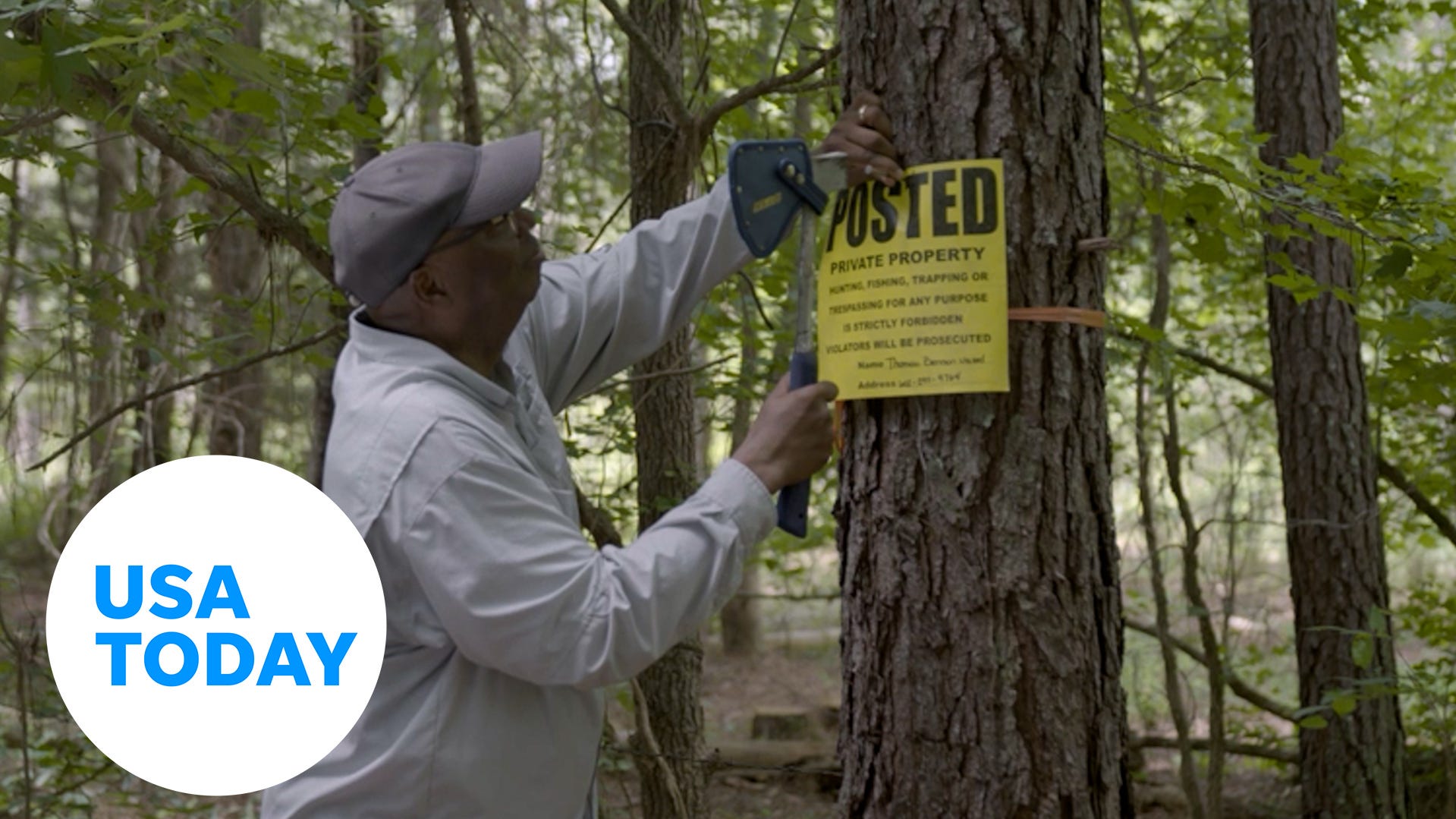
Revealed! A black landowner’s battle for justice
Saul Blair is fulfilling a promise made to his late mother by battling to retain and manage land bought by his great-grandfather in Rayle, Georgia.
“The Heir’s Property” is an in-depth look at the issue of land passed down through generations, told through the lens of one man’s struggle to retain land purchased a century ago by his great-grandfather, who was born into slavery during the Confederacy. Heirs’ property is usually defined as land handed down without clear, official documentation. Over the course of the 20th century, Black Americans lost roughly 80% of the property they owned at the peak of ownership a few decades after the Civil War because of theft and systemic injustices. This is the first in a two-part series.
It was a hot July afternoon, and Saul Blair stood at the edge of a forest in northern Georgia, watching a pickup truck bounce along a rutted dirt road.
Blair is a retired health care executive who wore a suit and tie to work every day, long after everyone else switched to khakis. At one point in his career, as regional director for a national company, his territory − Arizona and part of New Mexico − generated 40% of the revenue for the entire country.
On this day, he wore the body armor of a modern weekend warrior: Patagonia sweat-wicking, sun-blocking separates; trail running shoes; bug spray.
For all that, the land had gotten under his skin.
The property had been purchased by Blair’s great-grandfather, John Thomas, Jr., a man born into slavery in 1859 who nonetheless managed the incredible: acquiring more than 300 acres deep in the heart of the Confederacy and dividing it among his 11 children when he died.
Blair inherited the plots owned by his mother, Amminita Benson-Blair, who begged Saul on her deathbed in 2010 to “not lose Grandaddy’s land.” He has spent the better part of his retirement − and a lot of time in the years before it − trying to honor that request.
How hard could it be to “not lose” several dozen acres of land? In a nation where the scars of slavery and racialized violence still loom, pretty hard, as it turns out. Researchers estimate that between 1865 and 1910, Black Americans acquired 15 million acres of land. But by 2001, an estimated 80% of it had been lost.
“Lost” can mean several things: sold for pennies on the dollar by ancestors who had no other options, seized in a tax lien sale or foreclosure auction, taken by scammers, held in indefinite legal limbo when succeeding generations have so many part-owners that they can’t agree on anything.
Blair’s records are meticulous and his research extensive. His two parcels of property are held in trust by LLCs he organized. He has an agreement with a program from the U.S. Department of Agriculture and a good relationship with Georgia’s state Forestry Commission. He knows about property law, forest management and local history thanks to his yearslong odyssey to make the land his own.
Yet the man driving toward him was about the 17th logger Blair had contacted over the past year and a half. As part of the agreement with the USDA, some trees needed to be cut down and hauled out. Most loggers told him the job was too small to be worth their while. Some said conditions were too wet, or the trees were too young. Many simply never called back.
Blair had higher hopes for the man maneuvering toward him that morning. Charles Ware was a family friend. He was a jack-of-all-trades, not the owner of an established logging company, and was hungrier for the work. He was also Black.
For all his advantages − and Blair knew he was one of the lucky ones − wrangling the land often felt futile. He felt it slipping through his fingers, little by little. The primary purpose of his visit was hiring a logger, but the more he learned about the roadblocks faced by Thomas’ other descendants, the more he despaired.
“If I can’t make this work, other Black landowners are doomed,” he said.
John Thomas Jr.
John Thomas Jr. spent $4,735.60 − about $107,000 in today’s dollars − for 306.59 acres of farmland in Rayle, a speck of a town two hours east of Atlanta. When he died, one parcel went to Lizzie Thomas, who later married Alfred Benson. Amminita, Blair’s mother, was their daughter.
Saul Blair was born in Los Angeles in 1949. He’s the middle child, with one older and one younger sister. His father was often absent, and he was gone by the time Saul graduated high school.
At age 16, Blair started working in a hospital over spring vacation, filing, pulling patient charts, and doing other clerical work. He stayed on, going to school from morning to midafternoon, then worked at the hospital from about 3 to 11 p.m.
He kept up that schedule through four years at UCLA, and when he graduated, he started working at the hospital full time. All told, he spent nearly two decades there. He got married and had three sons.
In 1984, a memory tugged at him. He asked a legal firm affiliated with the hospital to track down what had become of the land his great-grandfather left to his children.
A lawyer named Cheri Laverty returned an astonishing four-page document tracing each of the 11 plots − she called them “tracks” or “tracts,” variously − through the previous five decades. Some of the plots had been foreclosed on; some had been sold, including one for as little as $10. Laverty included a hand-sketched family tree of sorts, noting the transactions.
“In summarizing, I think that you can safely assume that Tract Nos. 1, 5, 6, 7, 8 have been legally transferred to people outside of your family,” Laverty wrote.
Not even 50 years had passed since Thomas died, and half of his legacy was gone.
Blair read the report, put it in a desk drawer and carried on with his life: raising his sons and advancing a hard-charging career.
What is heirs’ property?
Property that passes informally between generations may be one of the thorniest yet least-acknowledged challenges facing Black Americans today. One of the most comprehensive estimates suggests there’s well over $30 billion worth of such property throughout the country, much of it in the Deep South and Appalachia.
Though Americans of all backgrounds have personal experience with family property transfers that don’t go smoothly, it may be particularly resonant among Black and Native American communities.
Fannie Mae, which wrote the analysis noted above, puts it this way: “Inherited properties can have title issues, which in some cases are a product of generations of systemic exclusion from financial and legal systems. Due to various racial and economic disparities, land retention and wealth acquisition are inhibited for some households due to property title issues.”
In 2020, Thomas Mitchell, a law professor, won a MacArthur Genius Grant for his work on heirs’ property legal reforms. One of Mitchell’s most crucial accomplishments was developing model legislation for states to protect heir-owners and streamline the process for resolving their estates.
The legislation, the Uniform Partition of Heirs Property Act, has become law in 22 states, including Georgia. In awarding the grant, the MacArthur Foundation said “Mitchell is remedying a major factor in the racial wealth gap.”
Saul Blair’s recognition of the enormity of the situation energizes his efforts.
“Is our family also the victim of inappropriate acquisition of land (by) whites?” he mused in June. “If it’s true, then we want our land back. It’s become my mission. And I don’t apologize to anybody.”
First steps
Blair left Cheri Laverty’s research untouched for nearly 20 years, but in the early 2000s, as his mother’s health declined, he pulled it out again and began to use the internet to do his own research.
He found an organization called the Federation of Southern Cooperatives, where an attorney helped him get the title establishing formal ownership of his parcel. With her guidance, Blair also set up the LLC with some of his cousins.
His research also led him to McIntosh SEED (Sustainable Environment and Economic Development), a rural community development organization. McIntosh SEED works across the Deep South and views its agricultural work as inseparable from fighting racism.
The group helped Blair develop a land management program and connected him to a branch of the USDA called the Natural Resources Conservation Service (NRCS). NRCS’s Environmental Quality Incentives Program (EQIP) helps farmers, ranchers and forest landowners work toward cleaner water and air, healthier soil and better conditions for wildlife.
EQIP can help small landowners offset some of the costs of maintaining their property, but perhaps even more valuable is the on-the-ground assistance Blair gets from a state agency that helps implement its plan.
Casey Tudor, a forester with the Georgia Forestry Commission, knows Blair’s two tracts like some people know their own backyards. During Blair’s June trip, Tudor explained that the most important reason to thin out trees is to allow more sunlight to penetrate the forest.
Georgia is the most-forested state in the nation, Tudor said in an interview with USA TODAY, which means that if someone inherits land there, it’s a good bet it’s going to “have timber all over it.” The success of some of the programs for landowners may mean more property is transitioning from agriculture toward forests.
An outbreak of pine beetles and 2024’s Hurricane Helene helped contribute to a glut of pulpwood in the market, however, which drove down the value of that wood and made loggers even less interested in investing resources on a small lot like Blair’s.
The Wilkes County Colony
Blair knows little about John Thomas’ life despite his extensive research. He spoke in June with Susan O’Donovan, a professor at the University of Memphis whose research focuses on the lives of formerly enslaved people in the period after the Civil War.
O’Donovan didn’t know about John Thomas before being contacted as part of this USA TODAY project but was familiar with the history of a group of formerly enslaved people from Wilkes County.
“A bunch of them pooled their money, formed what we now know as the Wilkes County Colony, and relocated into southwest Georgia, where they rented a plantation in Dougherty County,” O’Donovan said in an interview. It was just one example of freed people banding together in a world turned upside down by emancipation.
The federal government’s few attempts to transition the recently emancipated into the postwar economy were inadequate, historians believe. And life was hard. During the war, the South lost its place as the world’s major supplier of cotton, so by 1867, its economy was suffering, even as much of the land had been degraded by the crop itself.
Most work available to formerly enslaved people would have involved farming. Sharecropping − akin to indentured servitude − would have been the least appealing. One step up from that was working for someone else, usually a White farmer or plantation owner, for wages. That presented less risk but almost zero autonomy, and working conditions were often not much different from slavery.
One step up from “wage work” was renting your own land, which is how John Thomas started out. It was still risky, but it provided more independence.
“The best thing was to own your own land,” O’Donovan said. “If you could pay for your land, and if you could make enough every year to cover your taxes, you weren’t beholden to anybody. You bore the risk of the crop. But you could grow enough food to survive. You had an autonomy as a landholder that was denied to everybody else.”
O’Donovan speculates that Thomas took advantage of his limited autonomy as a renter to make additional streams of income however he could: growing fruit and vegetables for sale in nearby towns, or to the steamboat trade that sprung up along the Savannah River. He may also have cut wood for sale.
Thomas’ children probably contributed to the family’s income. Boys may have worked in the field, and girls may have been indoor domestic workers.
“These weren’t high-wage opportunities,” O’Donovan said. “But if you had the freedom to piece them together, which you’re not going to get if you’re a wage worker or a sharecropper, you could begin to generate that money.”
The document that recorded Thomas’ land purchase says he had previously rented it. He and others who had been enslaved would have been acutely aware of the importance of owning property, O’Donovan said, in large part from simply observing the race and power dynamics around them: White people owned, Black people did not.
The same notions about real estate we accept today − ”It’s an asset; you can pass it on to your children; this is how you build wealth” − would have been just as familiar then.
“Generations of African-Americans were not able to build wealth generation by generation, by accumulating property, being able to pay for their kids to go to college, all this stuff,” O’Donovan said. “That is what makes the middle class the middle class, which makes rich people rich. Yeah, housing is everything.”
The plot thickens
Of all the mysteries surrounding John Thomas’ life, one of the most confounding is how he pulled it off.
Blair had long assumed that Thomas had paid cash for the property, and O’Donovan confirmed it’s almost unimaginable that a Black man could have found a way to finance the purchase that wouldn’t have been so costly as to be prohibitive.
But recently, a detail on the purchase documents had caught Blair’s attention. Nine years had passed between when the landowners made Thomas a “bond for title,” whatever that was, and when the official ownership document was filed.
Had Thomas paid the White men installments on the property from 1909 to 1918? Blair found either scenario − that a formerly enslaved man could have come up with the equivalent of $100,000 cash, or that he could have trusted a White family to make good on a yearslong agreement in the same community where human beings had only recently been chattel property − equally dubious.
In late June, Blair traveled to Georgia with two first cousins. He and Linda Benson, 69, a special-education teacher who lives near him in Mesa, Arizona, spent little time together as children but have become close as adults. Another cousin, Carol Nickelson, is 84 and lives in Manhattan, retired from managerial roles at big companies like Verizon.
All are grandchildren of Lizzie Benson, one of John’s 11 children.
Blair is responsible for two of the original 11 parcels of land: Tract 3, which he manages via an LLC that includes the cousins and other descendants of Lizzie Benson, and Tract 4, which he bought from a distant cousin named Yolande Minor.
The purpose of the trip was hiring a logger for the two tracts, but they also took the opportunity to meet family. Blair had wanted to see Minor, but she was in the hospital. Instead, he and Benson had lunch with Ella Barnes and Vivian Gamble, sisters who were also Thomas’ great-granddaughters.
Barnes and Gamble had their own predicament. Their property had become landlocked. Outsiders had bought up some of Thomas’ property to their south, blocking their only access point. And at some time in the past few years, they discovered their tax bills were being sent to, and paid, by someone with no connection to the family, without their knowledge.
Over lunch, the sisters asked Benson and Blair to visit the tax office in the Rayles county seat on their behalf to sort out the tax question.
As they drove away, the two cousins were perplexed. How could a random stranger be paying the family’s taxes? They assumed Ella and Vivian would have to have been delinquent before such a thing could happen.
Blair, who’s usually good-natured, often half-joked that his inability to hire a logger felt like a “conspiracy.” Was this another collusion to deprive the family of their inheritance?
Coming Sunday: The Heir’s Property, Part 2







